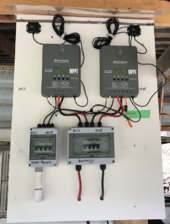Started this project a couple years ago. Pops had a tiny Harbor Freight solar panel plugged directly into an old tractor battery to supply lighting for his hunting cabin, which is quite literally, his home away from home. He loves the outdoors!
It began with almost a full pallet of 255w Trina panels purchased for my shop system, and since shipping is so darn expensive, purchased 4 more Mitsubishi 255w panels to fill out the pallet. The plan was to eventually use them for Pop's cabin.
The first system was a true bargain basement build. Through online research and reviews, the first SCC was a 30amp Weize, ~$80, which turns out to be sourced from SRNE. The 100v max mppt allowed for the use of 2 Mits 255w panels in series with their voc of ~38v. giving a bit of cold weather safety margin. With the Mits 255w. the Weize's rated 400watts max pv into 12v is slightly overpaneled, but these panels are used and probably not yielding 100% rated capacity. The panels wired in series allowed us to use 12gauge wire for the ~50' home run. Keep in mind, this is pretty far out in the woods, but we did run the pv lines in conduit, but used regular schedule 40 water line because of the price difference vs the grey pvc conduit. We used a heat gun to make shallow bends in the pvc where needed. These 2 steps saved us decent coin without any real drawbacks other than more time consumed heating/bending pipe. A single WalMart Neverstart deep cycle marine battery replaced the old tractor battery. After roughly a year, the single battery was replace with a home made battery box and 2 new WalMart Neverstart deep cycles.
This combo performed flawlessly. The cabin could set empty for weeks but when needed, everything just worked.
xxxxx
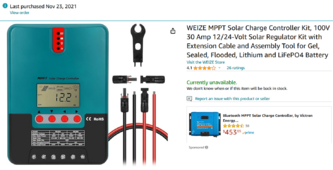
Fast forward to 23'. Still 2 Mits panels laying around the house that need a home and the cabin's propane heat (carbon monoxide and all that ... we had a friend and his son pass away because of a faulty heater) has always been concerning to me ... it sure would be nice, and safer, to go electric heat, sans generator of course.
Since the first SRNE had proven itself reliable and carried an economical price, a bit of research revealed that this Power Queen was also SRNE sourced. It's only 30amps, but 2 units gets you 60amps and a lower unit price,~$67 out the door.
xxx
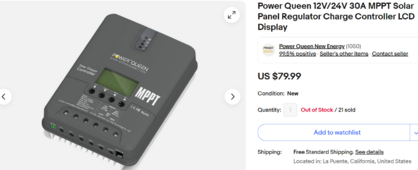
If you want bluetooth, the bt-1/PowerQueen can be purchased as a combo, or separately. The app isn't all that great but it works. There is a qr code in the manual for the app. The Renogy app also works.
Din rail boxes came from Amazon. Both boxes, 2 Chtaxi 16amp breakers for pv, 2 Chtaxi 40amp breakers for battery output, and wire glands were ~$140.
xxx

xxxx
Wire and lugs came from Temco. Good prices, and so far, decent quality. Not sure on the cost of all the cable and lugs as I have a lot of it laying around, but it does get expensive, and if you are on a tight budget, do not forget to factor in the copper.
xxx
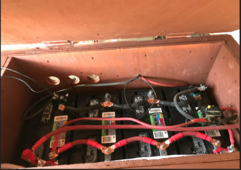
xxxx
New DIY battery box with 4 new Neverstarts. Put the other older batteries in the boat. MRBF fuses $10, holders $8, and covers $2, from Mouser. Eaton rates the MRBF interrupt rating to 10,000amps @14v. Anderson plug $26. With the Anderson plug and battery selector switch/precharge circuit, the inverter can easily be removed when not in use and locked inside.
One the AC side; Jupiter 2000w pure sine wave inverter, open box $170. Heavy duty marine battery selector switch $25 for inverter power on/off/precharge. The precharge circuit is diy and built into the selector switch. It consists of a couple 20ohm 10watt sandcast resistors and a red diode, $2.
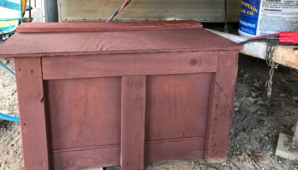
It began with almost a full pallet of 255w Trina panels purchased for my shop system, and since shipping is so darn expensive, purchased 4 more Mitsubishi 255w panels to fill out the pallet. The plan was to eventually use them for Pop's cabin.
The first system was a true bargain basement build. Through online research and reviews, the first SCC was a 30amp Weize, ~$80, which turns out to be sourced from SRNE. The 100v max mppt allowed for the use of 2 Mits 255w panels in series with their voc of ~38v. giving a bit of cold weather safety margin. With the Mits 255w. the Weize's rated 400watts max pv into 12v is slightly overpaneled, but these panels are used and probably not yielding 100% rated capacity. The panels wired in series allowed us to use 12gauge wire for the ~50' home run. Keep in mind, this is pretty far out in the woods, but we did run the pv lines in conduit, but used regular schedule 40 water line because of the price difference vs the grey pvc conduit. We used a heat gun to make shallow bends in the pvc where needed. These 2 steps saved us decent coin without any real drawbacks other than more time consumed heating/bending pipe. A single WalMart Neverstart deep cycle marine battery replaced the old tractor battery. After roughly a year, the single battery was replace with a home made battery box and 2 new WalMart Neverstart deep cycles.
This combo performed flawlessly. The cabin could set empty for weeks but when needed, everything just worked.
xxxxx

Fast forward to 23'. Still 2 Mits panels laying around the house that need a home and the cabin's propane heat (carbon monoxide and all that ... we had a friend and his son pass away because of a faulty heater) has always been concerning to me ... it sure would be nice, and safer, to go electric heat, sans generator of course.
Since the first SRNE had proven itself reliable and carried an economical price, a bit of research revealed that this Power Queen was also SRNE sourced. It's only 30amps, but 2 units gets you 60amps and a lower unit price,~$67 out the door.
xxx

If you want bluetooth, the bt-1/PowerQueen can be purchased as a combo, or separately. The app isn't all that great but it works. There is a qr code in the manual for the app. The Renogy app also works.
Din rail boxes came from Amazon. Both boxes, 2 Chtaxi 16amp breakers for pv, 2 Chtaxi 40amp breakers for battery output, and wire glands were ~$140.
xxx

xxxx
Wire and lugs came from Temco. Good prices, and so far, decent quality. Not sure on the cost of all the cable and lugs as I have a lot of it laying around, but it does get expensive, and if you are on a tight budget, do not forget to factor in the copper.
xxx

xxxx
New DIY battery box with 4 new Neverstarts. Put the other older batteries in the boat. MRBF fuses $10, holders $8, and covers $2, from Mouser. Eaton rates the MRBF interrupt rating to 10,000amps @14v. Anderson plug $26. With the Anderson plug and battery selector switch/precharge circuit, the inverter can easily be removed when not in use and locked inside.
One the AC side; Jupiter 2000w pure sine wave inverter, open box $170. Heavy duty marine battery selector switch $25 for inverter power on/off/precharge. The precharge circuit is diy and built into the selector switch. It consists of a couple 20ohm 10watt sandcast resistors and a red diode, $2.

Attachments
Last edited:



